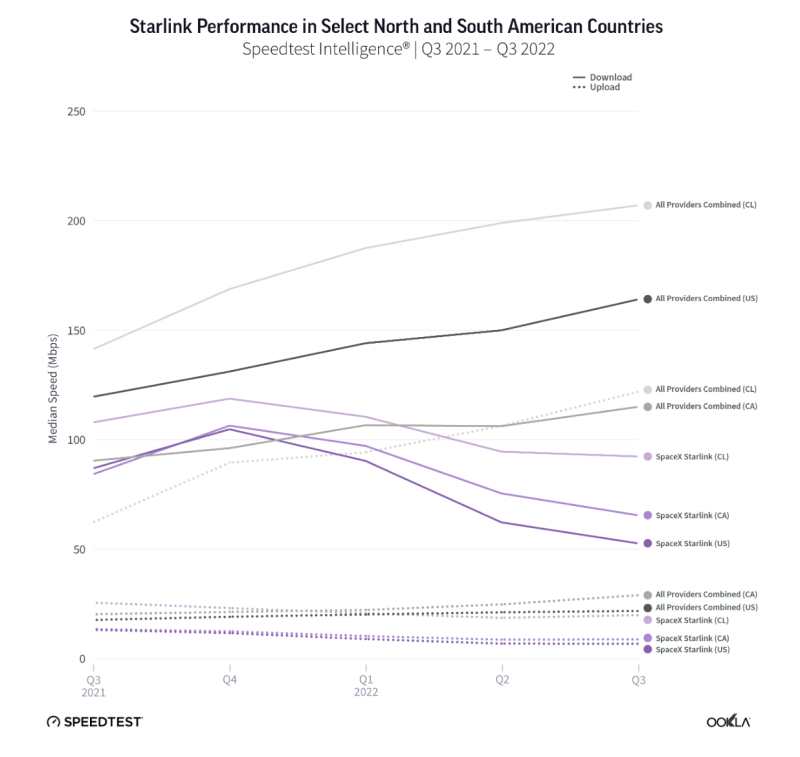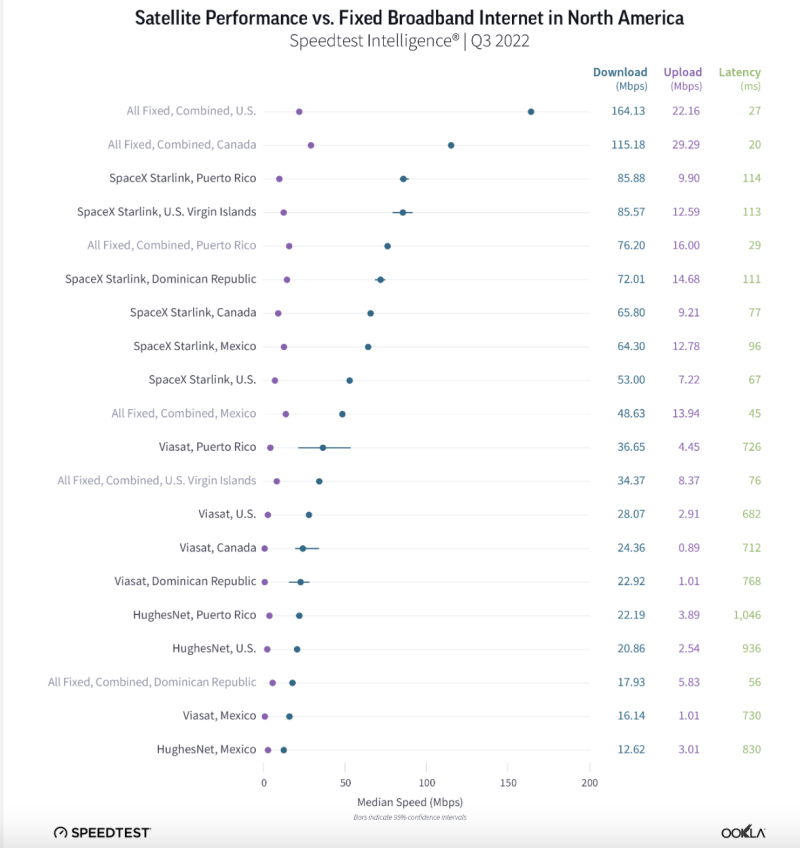While SpaceX’s Starlink is trying to convince the Federal Communications Commission (FCC) to allow it to deploy thousands more satellites, Ookla data about Starlink’s internet speeds is not helping its case.
Today, Ookla published fresh data from Q3 2022 for Starlink, HughesNet and Viasat in North and South America.
Ookla found that Starlink median download speeds dropped once again in Canada (at least 14%) and the U.S. (at least 17%) from Q2 to Q3 2022. During the same period, fixed broadband performance from other technologies besides satellite raced ahead, improving at least 8% to 115.18 Mbps in Canada and at least 8% to 164.13 Mbps in the U.S.
“Over the past year, as we’ve seen more users flock to sign up for Starlink (reaching 400,000 users worldwide during Q2 2022), speeds have started to decrease,” wrote Ookla. Although the research company did say that “Starlink often can be a life-changing service for consumers where connectivity is inadequate or nonexistent.”
According to Ookla data, Starlink speeds in the U.S. peaked in the fourth quarter 2021 and have been on a downhill trajectory ever since.

For the third quarter Starlink median speeds in the U.S. clocked it at 53 Mbps download and 7.22 Mbps upload. In Canada the Q3 median speeds were 65.8 Mbps download and 9.21 Mbps upload.

Ookla noted that Starlink upload speeds remained roughly unchanged from Q2.
Over the past year, Starlink has proliferated across the U.S., from having at least 10 unique users in 776 U.S. counties, or roughly 25% of all counties during Q2-Q3 2021 to 2,399 counties in Q2-Q3 2022, or roughly 75% of counties. That marks about a 200% increase year over year.
According to Ookla’s data, Starlink in Puerto Rico and the U.S. Virgin Islands had the fastest median download speed among satellite providers in North America at 85.88 Mbps and 85.57 Mbps during Q3 2022.
But the trend has been for Starlink speeds to decrease in areas once more users sign up or where some customers use excessive amounts of data.
RELATED: Starlink will restrict data usage for power users
For “power users” Starlink will now cap monthly usage at one terabyte of data. If a subscriber exceeds that amount, they will have their connection throttled for the rest of the billing cycle. Or, they can pay $0.25 for each additional GB of priority data. Business users will be charged $1 per additional GB of data.
Starlink and the FCC
Starlink has about 4,400 first-gen satellites in orbit, and it wants to deploy nearly 30,000 second-generation satellites. The company envisions placing the satellites at various low earth orbits from 340 kilometers up to 614 kilometers.
But the FCC has not yet given it the greenlight.
Meanwhile, the FCC has expressed some displeasure with Starlink related to the FCC’s Rural Digital Opportunity Fund (RDOF) auction. Starlink was originally awarded $885.5 million in winning RDOF bids, which were intended to help it connect more than 640,000 unserved locations in 35 states. But after reviewing Starlink’s long-form RDOF application, the FCC rejected the bids.
At the time, the FCC cited Ookla data which showed Starlink’s broadband speeds were below the service benchmark set for its subsidies. It specifically pointed to Ookla data that showed Starlink’s uplink speeds came in well below the promised 20 Mbps.
Starlink has appealed the FCC’s denial of RDOF subsidies.